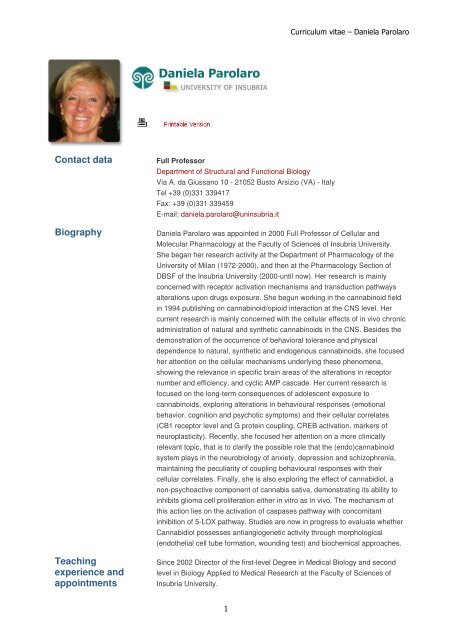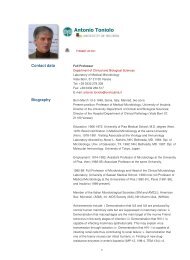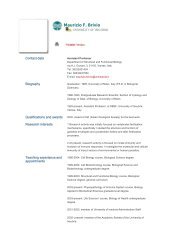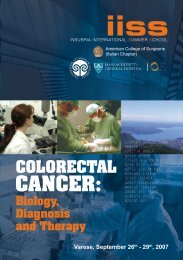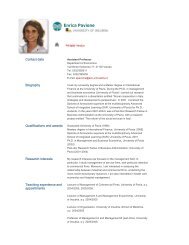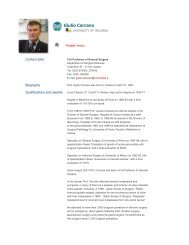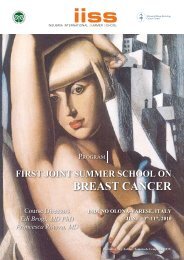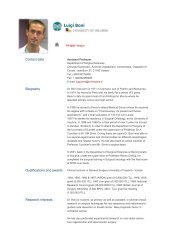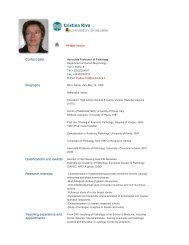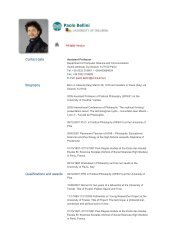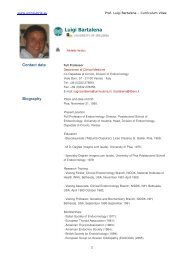Daniela Parolaro - The University of Insubria
Daniela Parolaro - The University of Insubria
Daniela Parolaro - The University of Insubria
Create successful ePaper yourself
Turn your PDF publications into a flip-book with our unique Google optimized e-Paper software.
Curriculum vitae – <strong>Daniela</strong> <strong>Parolaro</strong><br />
<strong>Daniela</strong> <strong>Parolaro</strong><br />
Contact data<br />
Biography<br />
Teaching<br />
experience and<br />
appointments<br />
Full Pr<strong>of</strong>essor<br />
Department <strong>of</strong> Structural and Functional Biology<br />
Via A. da Giussano 10 - 21052 Busto Arsizio (VA) - Italy<br />
Tel +39 (0)331 339417<br />
Fax: +39 (0)331 339459<br />
E-mail: daniela.parolaro@uninsubria.it<br />
<strong>Daniela</strong> <strong>Parolaro</strong> was appointed in 2000 Full Pr<strong>of</strong>essor <strong>of</strong> Cellular and<br />
Molecular Pharmacology at the Faculty <strong>of</strong> Sciences <strong>of</strong> <strong>Insubria</strong> <strong>University</strong>.<br />
She began her research activity at the Department <strong>of</strong> Pharmacology <strong>of</strong> the<br />
<strong>University</strong> <strong>of</strong> Milan (1972-2000), and then at the Pharmacology Section <strong>of</strong><br />
DBSF <strong>of</strong> the <strong>Insubria</strong> <strong>University</strong> (2000-until now). Her research is mainly<br />
concerned with receptor activation mechanisms and transduction pathways<br />
alterations upon drugs exposure. She begun working in the cannabinoid field<br />
in 1994 publishing on cannabinoid/opioid interaction at the CNS level. Her<br />
current research is mainly concerned with the cellular effects <strong>of</strong> in vivo chronic<br />
administration <strong>of</strong> natural and synthetic cannabinoids in the CNS. Besides the<br />
demonstration <strong>of</strong> the occurrence <strong>of</strong> behavioral tolerance and physical<br />
dependence to natural, synthetic and endogenous cannabinoids, she focused<br />
her attention on the cellular mechanisms underlying these phenomena,<br />
showing the relevance in specific brain areas <strong>of</strong> the alterations in receptor<br />
number and efficiency, and cyclic AMP cascade. Her current research is<br />
focused on the long-term consequences <strong>of</strong> adolescent exposure to<br />
cannabinoids, exploring alterations in behavioural responses (emotional<br />
behavior, cognition and psychotic symptoms) and their cellular correlates<br />
(CB1 receptor level and G protein coupling, CREB activation, markers <strong>of</strong><br />
neuroplasticity). Recently, she focused her attention on a more clinically<br />
relevant topic, that is to clarify the possible role that the (endo)cannabinoid<br />
system plays in the neurobiology <strong>of</strong> anxiety, depression and schizophrenia,<br />
maintaining the peculiarity <strong>of</strong> coupling behavioural responses with their<br />
cellular correlates. Finally, she is also exploring the effect <strong>of</strong> cannabidiol, a<br />
non-psychoactive component <strong>of</strong> cannabis sativa, demonstrating its ability to<br />
inhibits glioma cell proliferation either in vitro as in vivo. <strong>The</strong> mechanism <strong>of</strong><br />
this action lies on the activation <strong>of</strong> caspases pathway with concomitant<br />
inhibition <strong>of</strong> 5-LOX pathway. Studies are now in progress to evaluate whether<br />
Cannabidiol possesses antiangiogenetic activity through morphological<br />
(endothelial cell tube formation, wounding test) and biochemical approaches.<br />
Since 2002 Director <strong>of</strong> the first-level Degree in Medical Biology and second<br />
level in Biology Applied to Medical Research at the Faculty <strong>of</strong> Sciences <strong>of</strong><br />
<strong>Insubria</strong> <strong>University</strong>.<br />
1
Curriculum vitae – <strong>Daniela</strong> <strong>Parolaro</strong><br />
Since 2005 Coordinator <strong>of</strong> the PhD course in Neurobiology <strong>of</strong> the <strong>University</strong> <strong>of</strong><br />
<strong>Insubria</strong><br />
From 1997 to 2000 Director <strong>of</strong> the Center <strong>of</strong> Behavioral Pharmacology and<br />
Dependence, <strong>University</strong> <strong>of</strong> Milan and now member <strong>of</strong> the scientific committee.<br />
Member <strong>of</strong> the Evaluation Committee <strong>of</strong> the <strong>University</strong> <strong>of</strong> <strong>Insubria</strong>.<br />
In 2006 President <strong>of</strong> the International Cannabinoid Research Society.<br />
Since 2002 President <strong>of</strong> the Neuroscience Center, <strong>University</strong> <strong>of</strong> <strong>Insubria</strong><br />
Member <strong>of</strong> the Board <strong>of</strong> the Internatiional Association <strong>of</strong> Cannabis as<br />
Medicine (IACM)<br />
Member <strong>of</strong> the committee for the PhD course in Pharmacology <strong>of</strong> the<br />
<strong>University</strong> <strong>of</strong> Milan<br />
Member <strong>of</strong> the Committee <strong>of</strong> Academic Pharmacologists<br />
Member <strong>of</strong> the Italian Society <strong>of</strong> Pharmacology, Italian Society <strong>of</strong><br />
Neuropsychopharmacology, Italian Society <strong>of</strong> Neuroscience, International<br />
Cannabinoid Research Society.<br />
Representative<br />
publications<br />
Original papers:<br />
- Rubino T, Realini N, Castiglioni C, Guidali C, Viganó D, Marras E, Petrosino<br />
S, Perletti G, Maccarrone M, Di Marzo V, <strong>Parolaro</strong> D. Role in Anxiety Behavior<br />
<strong>of</strong> the Endocannabinoid System in the Prefrontal Cortex. Cereb Cortex. 2007<br />
Oct 5;<br />
- Rubino T, Guidali C, Vigano D, Realini N, Valenti M, Massi P, <strong>Parolaro</strong> D.<br />
CB1 receptor stimulation in specific brain areas differently modulate anxietyrelated<br />
behaviour. Neuropharmacology. 2007 Jul 6;<br />
- Agarwal N, Pacher P, Tegeder I, Amaya F, Constantin CE, Brenner GJ,<br />
Rubino T, Michalski CW, Marsicano G, Monory K, Mackie K, Marian C, Batkai<br />
S, <strong>Parolaro</strong> D, Fischer MJ, Reeh P, Kunos G, Kress M, Lutz B, Woolf CJ,<br />
Kuner R. Cannabinoids mediate analgesia largely via peripheral type 1<br />
cannabinoid receptors in nociceptors. Nat Neurosci. 2007 Jul;10(7):870-9.<br />
- Fattore L, Viganò D, Fadda P, Rubino T, Fratta W, <strong>Parolaro</strong> D. Bidirectional<br />
regulation <strong>of</strong> mu-opioid and CB1-cannabinoid receptor in rats selfadministering<br />
heroin or WIN 55,212-2. Eur J Neurosci. 2007 Apr;25(7):2191-<br />
200.<br />
- Rubino T, Sala M, Viganò D, Braida D, Castiglioni C, Limonta V, Guidali C,<br />
Realini N, <strong>Parolaro</strong> D. Cellular mechanisms underlying the anxiolytic effect <strong>of</strong><br />
low doses <strong>of</strong> peripheral Delta9-tetrahydrocannabinol in rats.<br />
Neuropsychopharmacology. 2007 Sep;32(9):2036-45.<br />
- Rubino T, Viganò D, Premoli F, Castiglioni C, Bianchessi S, Zippel R,<br />
<strong>Parolaro</strong> D. Changes in the expression <strong>of</strong> G protein-coupled receptor kinases<br />
and beta-arrestins in mouse brain during cannabinoid tolerance: a role for<br />
2
Curriculum vitae – <strong>Daniela</strong> <strong>Parolaro</strong><br />
RAS-ERK cascade. Mol Neurobiol. 2006 Jun;33(3):199-213.<br />
- Massi P, Vaccani A, Bianchessi S, Costa B, Macchi P, <strong>Parolaro</strong> D. <strong>The</strong> nonpsychoactive<br />
cannabidiol triggers caspase activation and oxidative stress in<br />
human glioma cells. Cell Mol Life Sci. 2006 Sep;63(17):2057-66.<br />
- Viganò D, Rubino T, Vaccani A, Bianchessi S, Marmorato P, Castiglioni C,<br />
<strong>Parolaro</strong> D. Molecular mechanisms involved in the asymmetric interaction<br />
between cannabinoid and opioid systems. Psychopharmacology (Berl). 2005<br />
Nov;182(4):527-36.<br />
- Rubino T, Forlani G, Viganò D, Zippel R, <strong>Parolaro</strong> D. Ras/ERK signalling in<br />
cannabinoid tolerance: from behaviour to cellular aspects. J Neurochem. 2005<br />
May;93(4):984-91.<br />
- Vaccani A, Massi P, Colombo A, Rubino T, <strong>Parolaro</strong> D. Cannabidiol inhibits<br />
human glioma cell migration through a cannabinoid receptor-independent<br />
mechanism. Br J Pharmacol. 2005 Apr;144(8):1032-6.<br />
Reviews:<br />
- Massi P, Vaccani A, <strong>Parolaro</strong> D. Cannabinoids, immune system and<br />
cytokine network. Curr Pharm Des. 2006;12(24):3135-46.<br />
- <strong>Parolaro</strong> D, Viganò D, Rubino T. Endocannabinoids and drug dependence.<br />
Curr Drug Targets CNS Neurol Disord. 2005 Dec;4(6):643-55.<br />
- Viganò D, Rubino T, <strong>Parolaro</strong> D. Molecular and cellular basis <strong>of</strong> cannabinoid<br />
and opioid interactions. Pharmacol Biochem Behav. 2005 Jun;81(2):360-8.<br />
Book chapters:<br />
- <strong>Parolaro</strong> D., Rubino T. Cannabinoids and drug <strong>of</strong> abuse. In: Cannabinoids<br />
as therapeutics. (ed. R. Mechoulam) Birkhauser Verlag: Basel 2005; pp.207-<br />
218.<br />
- Massi P., Vaccani A., <strong>Parolaro</strong> D. Cannabinoids and immune system. In:<br />
Recent advances in pharmacology and physiology <strong>of</strong> cannabinoids. (ed. T.<br />
Wenger) Research signpost: Kerala 2004; pp. 119-137.<br />
3


